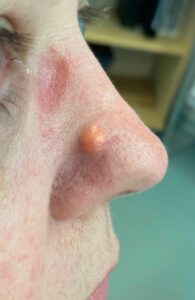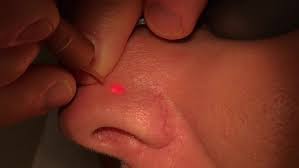Fibrous Papules are composed of dilated blood vessels, fibroblasts, collagen, or skin cells and supporting material, as seen under a microscope. These tumors are known as the fibrous papules of the face because they are frequently found on the face and arise in a single location.
Table of Contents
What is a fibrous papule?
Fibrous papules are benign growths that show as hard nodules on the sides of the nose or on the wings of the nostrils. The majority of the time, there is only one papule, although there might be several at the same time.
Affected areas such as the face and neck, as well as the lip and forehead, can develop fibrous papules. A fibrous papule is often shaped like a little dome, however, it can occasionally grow up a little more, like a wart in progress.
The papules are usually hard, vary in hue from skin-toned to pink to red, and range in size from 1 to 6 millimeters in diameter in the majority of cases.
Causes of Fibrous Papule
The cause of fibrous papules is still unknown. When studied under a microscope, fibrous papules are fibrous masses that include collagen and blood vessels.
Regardless of what color or ethnicity an individual belongs to, middle-aged men and women are equally prone to develop fibrous papules on their noses.
Fibrous papules, which are benign or noncancerous skin growths, can form as a result of the aging process. Fibrous papules can also appear in some people who have no underlying medical problem.
The development of numerous fibrous papules may be related to the existence of genetic disorders and other conditions. When these factors are present, it is normal for the papules to extend beyond the nasal area and appear to be many and distributed.
Aside from whatever psychological impacts they may have, they are absolutely harmless in most cases.
What are the symptoms of fibrous papules?
While fibrous papules are normally innocuous, they can occasionally cause cosmetic concerns.
Among the symptoms of fibrous papules are the following:
- On the nose, small, benign growths are frequent.
- They are typically round or oval in shape and range in color from the skin to reddish-brown.
- Fibrous papules are commonly 1 to 5 millimeters in diameter.
- There won’t be any discomfort or itching associated with the fibrous papule. When rubbed or scratched, papules may become inflamed or bleed.
How is a fibrous papule diagnosed?
In order to distinguish fibrous papule from other skin conditions, such as a tumor of the hair follicle or skin cancer such as basal cell carcinoma, a biopsy of the skin is appropriate.
There will be no pain or itching associated with the fibrous papule. When irritated or scratched, papules can become inflamed and bleed.
The nose or the area around the nose is frequently the site of a single, solitary skin lesion. This type of tumor is rarely associated with any other symptoms.
A histology test may necessitate the removal of these lesions for cosmetic reasons or for other reasons.
Treatments for Fibrous Papule
Fibrous papules are harmless, do not need treatment, and remain stable. They can be removed for aesthetic reasons, but these may leave a scar.
Fibrous papules rarely reappear after they’ve been removed. Here are some treatment options that your doctor may propose:
Shave Excision. When your healthcare provider needs to keep a sample of the growth for lab analysis, they will employ this method. After the skin has been numbed, a surgical curette will be used to remove the growth and even the skin. The shaved growth will then be sent to a laboratory for analysis.
Electrocautery. Thermal energy created by the electrical charge in an electrical cautery needle is used to burn lesions during this treatment. An electrically charged needle heats and vaporizes the bump. A scab will form and break off after five to 10 days. As a result of utilizing this procedure, some discoloration may develop.
Cryotherapy. Fibrous Papule can be treated with cryotherapy, which involves freezing the nodes with liquid nitrogen until they die. Cryotherapy is less effective than electrocautery and typically requires repeated treatments before the growth is entirely eliminated. If you choose this option, some discoloration may occur.
Laser therapy. To treat fibrous papules, several lasers were employed. A specialist can remove the nodes off the surface of the skin using a laser. Because there are so many lasers on the market, consulting a dermatologist and having your skin evaluated is the best way to determine which laser is best for your specific concerns and problems.
What Happens After Fibrous Papule Removal
A little scar that has altered in texture and color may be visible in the place where the fibrous papule was removed if you look closely at it.
A tiny scab will emerge on the treated region after 5 days. This line of therapy necessitates the use of vaseline four times each day, and minor lesions heal relatively fast.
We ask that you refrain from engaging in any intense physical activity for the remainder of the day. It is vitally critical that the treated areas remain dry and clean at all times.
You can clean them with a cotton pad and water once or twice a day, depending on your preference. After undergoing a medical procedure, most people are able to return to their current jobs quickly.
What are the risks of having a fibrous papule removal procedure?
Fibrous papule removal procedures carry a number of risks, including:
Infection
There is a risk of infection following any type of surgery. In the case of fibrous papule removal, this can occur due to the use of a scalpel or other instruments that may introduce bacteria into the wound. It is important to keep the surgical site clean and dry in order to minimize the risk of infection.
Bleeding
There is always a risk of bleeding during and after surgery. This may be due to the nature of the fibrous papules themselves or due to the surgical procedure used to remove them.
Scarring
Fibrous papule removal procedures may leave scars behind. It is important to discuss the potential for scarring with your surgeon before deciding on a fibrous papule removal procedure.
Consult Your Doctor
If the fibrous papule is deemed suitable for removal, a team of experts will conduct a complete investigation to decide whether or not tests will be required in order to confirm the diagnosis.
Any changes in your skin, as well as the emergence of any new symptoms, should be discussed with your doctor.
A medical practitioner can assist you in determining the most appropriate treatment option for your growth based on the type and location of the growth.
Knowing the difference between fibrous papules and other skin conditions is important because they can appear to be the same.
A dermatologist should be seen if you find a node on your skin that appears to be different. Those with suspected fibrous papule growths can be checked and treated by dermatologists at Team Dermatology, which has clinics in Memorial and Sugarland, Texas.
Make a consultation appointment at any of our locations for immediate assistance.




